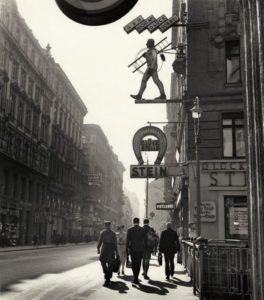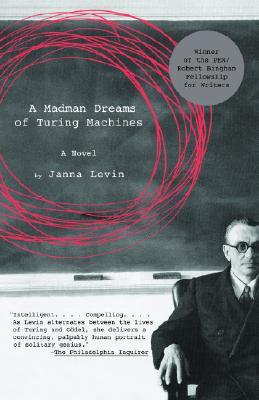There is nothing in the colliding worlds of science, literature and art better than Maria Popova’s magnificent Brain Pickings. Here she is meditating on her beloved Janna Levin and the book A Madman Dreams of Turing Machines: If it is true — and true it is — that creativity blooms when seemingly unrelated ideas are cross-pollinated into something novel, then its most fecund ground is an environment where minds of comparable caliber but divergent obsession come together and swirl their ideas into a common wellspring of genius. There is hardly more concrete a testament to this principle than the Vienna Circle — the collective of scientists, philosophers, and novelists, who met in Europe in the first decades of the twentieth century and shaped modern culture by bringing art and science into intimate, fertile contact. But in the 1930s, as they demolished the boundaries between these disciplines, the Vienna Circle also exposed the limits of logic as a sensemaking mechanism for the nature of reality, limitation being perhaps as necessary to creativity as freedom of thought.
The paradigm-shifting ideas that emerged from that unusual petri dish are what cosmologist and novelist Janna Levin explores throughout A Mad Man Dreams of Turing Machines (public library) — her lyrical and darkly enthralling novel, partway between magical realism and poetry, yet guided by science and rigorously grounded in the real lives of two of the twentieth century’s most tragic geniuses: computing pioneer Alan Turing and trailblazing mathematician Kurt Gödel.
The members of the Vienna Circle were endowed with minds exceeding the average not by degree but by kind — the kind of genius that risked bleeding into madness, nowhere more so than in Gödel. Levin paints his conflicting multitudes — the internal tensions that powered his, and perhaps power all, genius:
In 1931 he is a young man of twenty-five, his sharpest edges still hidden beneath the soft pulp of youth. He has just discovered his theorems. With pride and anxiety he brings with him this discovery. His almost, not-quite paradox, his twisted loop of reason, will be his assurance of immortality. An immortality of his soul or just his name? This question will be the subject of his madness.

Levin, who has written beautifully about the complex relationship between genius and madness, adds:
Here he is, a man in defense of his soul, in defense of truth, ready to alter the view of reality his friends have formulated on this marble table. He joins the Circle to tell the members that they are wrong, and he can prove it.
He is still all potential. The potential to be great, the potential to be mad. He will achieve both magnificently.
In his incompleteness theorems, which he began publishing that year, Gödel set out to prove that there are limits to how much of reality mathematical logic can grasp — something many intuited but none had substantiated. (Nearly a century earlier, the pioneering astronomer Maria Mitchell articulated that intuition, if not its empirical proof, in her diary: “The world of learning is so broad, and the human soul is so limited in power! We reach forth and strain every nerve, but we seize only a bit of the curtain that hides the infinite from us.”) With poetic precision, Levin conveys Gödel’s ideas and their broader significance:
Gödel will prove that some truths live outside of logic and that we can’t get there from here. Some people — people who probably distrust mathematics — are quick to claim that they knew all along that some truths are beyond mathematics. But they just didn’t. They didn’t know it. They didn’t prove it.
Gödel didn’t believe that truth would elude us. He proved that it would. He didn’t invent a myth to conform to his prejudice of the world — at least not when it came to mathematics. He discovered his theorem as surely as if it was a rock he had dug up from the ground. He could pass it around the table and it would be as real as that rock. If anyone cared to, they could dig it up where he buried it and find it just the same. Look for it and you’ll find it where he said it is, just off center from where you’re staring. There are faint stars in the night sky that you can see, but only if you look to the side of where they shine. They burn too weakly or are too far away to be seen directly, even if you stare. But you can see them out of the corner of your eye because the cells on the periphery of your retina are more sensitive to light. Maybe truth is just like that. You can see it, but only out of the corner of your eye.
But the truth is not something everyone wants to see — it can be inconvenient, even obstructionist. In the spring of 1936, as the ideas of the Vienna Circle were becoming increasingly threatening to the Nazi party rising to power, Moritz Schlick, chair of the Vienna Circle, was shot by a former student of his on the steps of the University of Vienna, where he taught. Meanwhile, Gödel’s swirling genius was spiraling further and further into madness. Having already necessitated psychiatric care two years earlier, he was destroyed anew upon hearing of Moritz’s murder and endured an even sharper nervous breakdown that landed him in a psychiatric institution. Levin writes:
In his quiet room in the sanatorium with the narrow window over the big groomed lawn, Gödel rested alone, slumped and motionless, and wondered, where did he go? Where is Moritz?
What does it mean to say that Moritz lived in the past? Nothing. The past does not exist. The notion of a past refers to a paltry and brittle memory, incomplete and flawed. Moritz is dead. He is lost but for fragments in the minds of those who have moved around the globe since his death. The Vienna Circle died with him as the headlines condemned Moritz Schlick as a Jew sympathizer who got what he deserved at the top of the stairs in the University of Vienna at the hands of a pan-Germanic hero who rightly killed this Jew philosopher. Moritz was a Protestant. Facts of the world are sealed in minds. People wear a facade. All of reality goes on behind their eyes, and there lie secret plans and hidden agendas. A tar of false motives and intentions. Truth mauled. Because the past does not exist except as a threadbare fragment in the weaker minds of the many.





